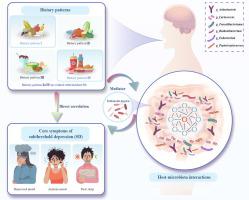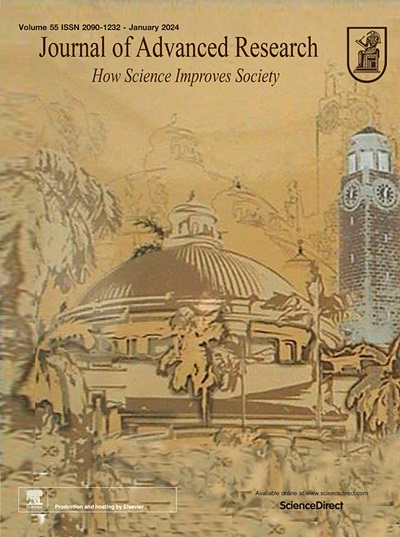中国年轻人特定饮食模式、肠道微生物组组成与亚阈值抑郁症事件之间的关系。
IF 11.4
1区 综合性期刊
Q1 MULTIDISCIPLINARY SCIENCES
引用次数: 0
摘要
导言:人们对影响因素与青壮年阈下抑郁症(SD)发病率之间的相互作用仍然知之甚少:本研究旨在了解青壮年亚阈值抑郁症患者的饮食习惯、肠道微生物群组成等,并探讨这些因素与亚阈值抑郁症发生的关系:方法:采用横断面方法,将 178 名 18-32 岁的 SD 患者与 114 名健康患者进行配对。采用Zung抑郁自评量表(SDS)、Zung焦虑自评量表(SAS)、贝克抑郁量表第二版(BDI-II)、17项汉密尔顿抑郁评分量表(HAMD-17)和匹兹堡睡眠质量指数(PSQI)评估SD状况。元基因组测序用于确定粪便微生物特征。通过对 25 项食物频率问卷(FFQ)进行因子分析,确定了饮食模式。研究人员进行了逻辑回归分析和中介分析,以探讨肠道微生物群、饮食模式和 SD 事件之间的潜在联系:共有 292 名参与者(平均 [SD] 年龄为 22.1 [2.9] 岁;216 [73.9 %] 为女性)提供了饮食习惯数据。逻辑回归分析显示,膳食模式Ⅰ(几率比[OR],0.34;95 % CI,0.15-0.75)和Ⅳ(OR,0.39;95 % CI,0.17-0.86 和 OR,0.39;95 % CI,0.18-0.84)与罹患 SD 的风险降低有关。在患有 SD 的年轻成人中观察到了不同的微生物特征,其特点是微生物多样性增加和分类改变。此外,中介分析表明,Veillonella atypica是将SDS或BDI-II评分与富含豆制品、粗粮、坚果、水果、蘑菇和马铃薯的健康饮食模式联系起来的潜在中介因子(β = 0.25,95 % CI:0.02-0.78;β = 0.18,95 % CI:0.01-0.54):我们的研究结果突显了膳食模式、肠道微生物群和年轻人罹患 SD 风险之间复杂的相互作用,强调了膳食干预和微生物群调节在促进心理健康方面的潜力。本文章由计算机程序翻译,如有差异,请以英文原文为准。


Associations between specific dietary patterns, gut microbiome composition, and incident subthreshold depression in Chinese young adults
Introduction
The interplay between influential factors and the incidence of subthreshold depression (SD) in young adults remains poorly understood.
Objectives
This study sought to understand the dietary habits, gut microbiota composition, etc. among individuals with SD in young adults and to investigate their association with SD occurrence.
Methods
Employing a cross-sectional approach, 178 individuals with SD, aged 18–32 years, were matched with 114 healthy counterparts. SD status was evaluated using the Zung Self-rating Depression Scale (SDS), Zung Self-rating Anxiety Scale (SAS), Beck Depression Inventory 2nd version (BDI-II), the 17-item Hamilton Rating Scales of Depression (HAMD-17), and Pittsburgh Sleep Quality Index (PSQI). Metagenomic sequencing was utilized to identify fecal microbial profiles. Dietary patterns were discerned via factor analysis of a 25-item food frequency questionnaire (FFQ). Logistic regression analysis and mediation analysis were performed to explore the potential links between gut microbiota, dietary patterns, and incident SD.
Results
Data on dietary habits were available for 292 participants (mean [SD] age, 22.1 [2.9] years; 216 [73.9 %] female). Logistic regression analysis revealed that dietary patterns Ⅰ (odds ratio [OR], 0.34; 95 % CI, 0.15–0.75) and IV (OR, 0.39; 95 % CI, 0.17–0.86 and OR, 0.39; 95 % CI, 0.18–0.84) were associated with reduced risk of SD. Distinct microbial profiles were observed in young adults with SD, marked by increased microbial diversity and taxonomic alterations. Moreover, mediation analysis suggested Veillonella atypica as a potential mediator linking SDS or BDI-II scores with a healthy dietary pattern rich in bean products, coarse grains, nuts, fruits, mushrooms, and potatoes (β = 0.25, 95 % CI: 0.02–0.78 and β = 0.18, 95 % CI: 0.01–0.54).
Conclusions
Our findings highlight the complex interplay between dietary patterns, gut microbiota, and the risk of developing SD in young adults, underscoring the potential for dietary interventions and microbiome modulation in mental health promotion.
求助全文
通过发布文献求助,成功后即可免费获取论文全文。
去求助
来源期刊

Journal of Advanced Research
Multidisciplinary-Multidisciplinary
CiteScore
21.60
自引率
0.90%
发文量
280
审稿时长
12 weeks
期刊介绍:
Journal of Advanced Research (J. Adv. Res.) is an applied/natural sciences, peer-reviewed journal that focuses on interdisciplinary research. The journal aims to contribute to applied research and knowledge worldwide through the publication of original and high-quality research articles in the fields of Medicine, Pharmaceutical Sciences, Dentistry, Physical Therapy, Veterinary Medicine, and Basic and Biological Sciences.
The following abstracting and indexing services cover the Journal of Advanced Research: PubMed/Medline, Essential Science Indicators, Web of Science, Scopus, PubMed Central, PubMed, Science Citation Index Expanded, Directory of Open Access Journals (DOAJ), and INSPEC.
 求助内容:
求助内容: 应助结果提醒方式:
应助结果提醒方式:


